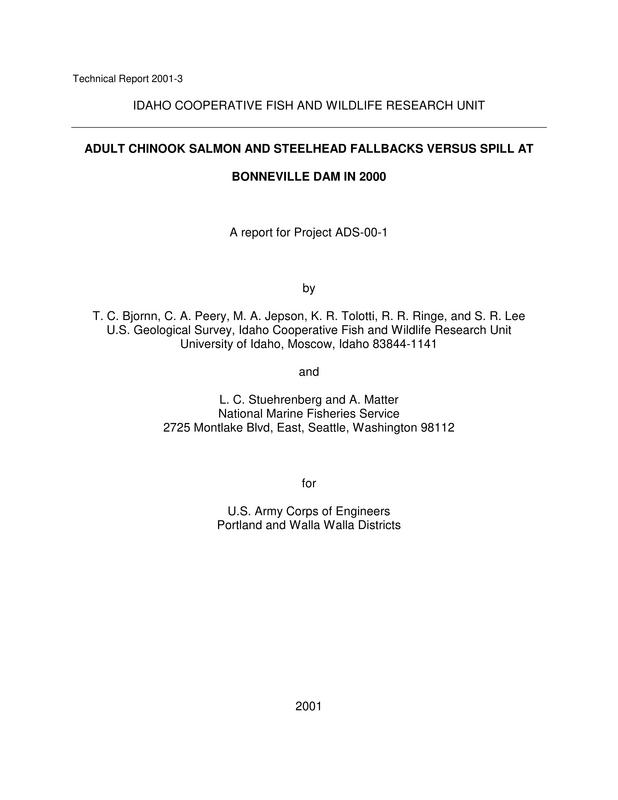PDF
Adult Chinook Salmon And Steelhead Fallbacks Versus Spill At Bonneville Dam In 2000 Item Info
- Title:
- Adult Chinook Salmon And Steelhead Fallbacks Versus Spill At Bonneville Dam In 2000
- Report Type:
- Technical Report
- Date:
- 2001
- Authors:
- Bjornn, T.C.; Peery, C.A.; Jepson, M.A.; Tolotti, K.R.; Ringe, R.R.; Lee, S.R.; Stuehrenberg, L.C.; Matter, A.
- Affiliations:
- Idaho Cooperative Fish and Wildlife Research Unit; National Marine Fisheries Service, National Oceanic and Atmospheric Administration
- Report Number:
- 2001-3
- Publisher:
- University of Idaho
- Funder:
- U.S. Army Corps of Engineers, Portland District; U.S. Army Corps of Engineers, Walla Walla District
- Abstract:
- A randomized block test was conducted to evaluate effects of high and low spill on fallback rates of adult salmon and steelhead at Bonneville Dam in 2000. Periods of low spill (50-75 kcfs) were alternated with periods of high spill (80-145 kcfs) during which the proportion of Chinook salmon and steelhead that fell back were compared. Overall, 1,624 Chinook salmon and steelhead passed through the two fishways, of which 180 fish (11.1%) fell back at Bonneville Dam, and of those, 1,449 fish and 168 fall backs were used in the analysis. Percent fallback for salmon and steelhead that passed through both fishways averaged 9.5% (+ 2.45%) during the low-spill treatment and 13.5% (+ 3.7%) during the high-spill treatment. When fallbacks that occurred more than 24 h after fish first exited fishways and those fallbacks from fish that moved upstream at least as far at Cascade Locks, Oregon (2.5 km) before falling back were removed from analysis, percent fallback averaged 6.2% (+ 2.1%) during the low-spill treatment and 9.3% (+ 2.5%) during the high-spill treatment. Fish that passed the dam using the Bradford Island fishway averaged percent fallback of 14.9% (+ 3.9%) during the low-spill treatment and 20.6% (+ 4.9%) during high spill. When fallbacks from the Bradford Island fishway that occurred more than 24 h after fish first exited fishways and those fallbacks from fish that moved upstream before falling back were removed from analysis, percent fallback averaged 10.2% (+ 2.9%) during the low-spill treatment and 15.8% (+ 3.6%) during high spill, the only comparison with a significant difference in percent fallback between high and low-spill treatments. Percent of fish that fell back were not significantly related to spill in regression analysis, which contrasts with results of our analysis of fallback at Bonneville Dam from previous years. It appears that a component of the fallback that occurs at Bonneville Dam each year may be independent of spill level.
- Species:
- Steelhead, Oncorhynchus mykiss Chinook salmon, Oncorhynchus tshawytscha
- Location:
- Columbia River; Bonneville Dam
- Subjects:
- salmonids Federal Columbia River Power System FCPRS radiotelemetry migration fishways experimental design fallback rates spill levels passage behavior
- Source:
- University of Idaho, Fish Ecology Research Lab
- Original Filename:
- 2001-03-CK-SH-Fallback-vs-Spill-Bonneville-2000.pdf
- Format:
- application/pdf
Source
- Preferred Citation:
- "Adult Chinook Salmon And Steelhead Fallbacks Versus Spill At Bonneville Dam In 2000", Adult Salmon and Steelhead Migration Studies: 1996-2014, University of Idaho Library Digital Collections, https://www.lib.uidaho.edu/digital/ferl/items/ferl-tr-2001-3.html
Rights
- Rights:
- These files are provided for research purposes with copyright held by the original authors. Please contact the publishing organization for more information about rights.
- Standardized Rights:
- http://rightsstatements.org/vocab/InC-EDU/1.0/

